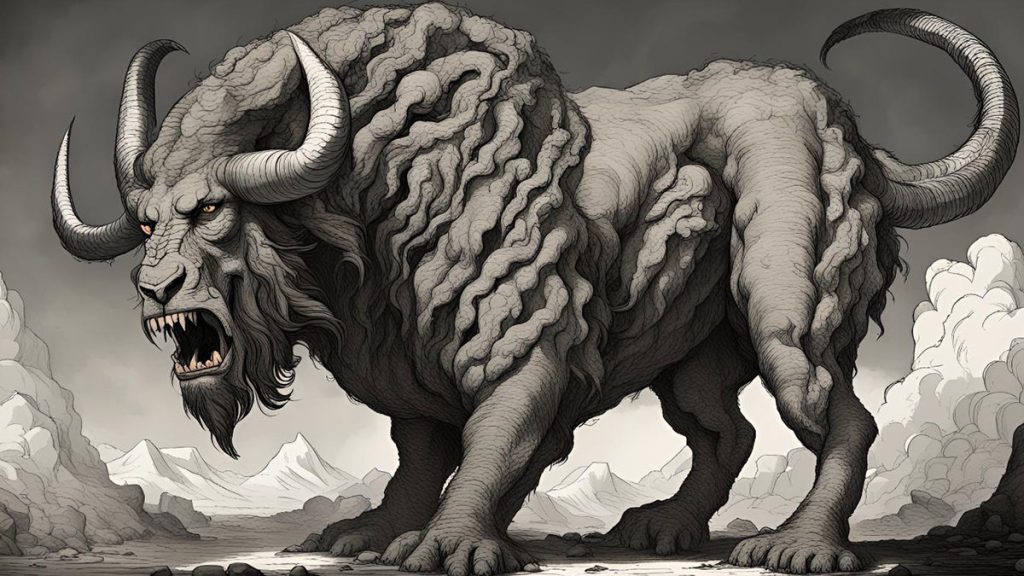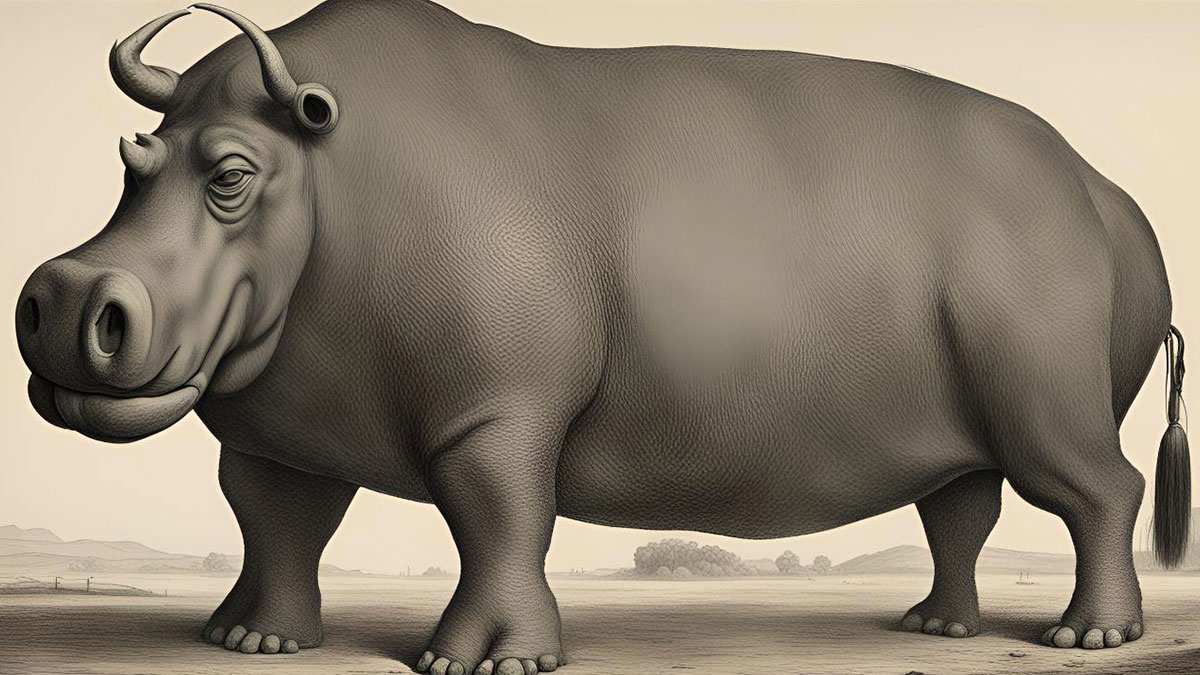The Behemoth is a mythical animal prevalent mainly in the Hebrew Bible and other Jewish religious texts and writings but also featured in the Christian Old Testament. The animal was created by God as one of the chaos creatures and is usually paired with the Leviathan.
The key feature of the behemoth is that it’s enormous and powerful, so much so that it cannot be defeated. It has the appearance of a giant ox or a hippopotamus. It has bones as hard as bronze, limbs as firm as rods of iron, and a tail that’s as tall as a cedar tree. It is a primordial creature, meaning it has been alive since the beginning of time.
The Behemoth lives near rivers and marshes, and perhaps surprisingly, for a creature often described as the King of the land animals, its diet consists of grass. The word Behemoth has become synonymous with something particularly large or powerful.
While the Behemoth rules over the land, another primordial creature, the sea serpent known as Leviathan, commands the oceans. Ancient texts also refer to a lesser-known third primordial being known as Ziz, a sky creature.
The Behemoth features in Hebrew and Christian Bible
The first known appearance of the Behemoth in literature was in chapter 40 of Job in the Hebrew and Christian Bibles. God described the animal to Job much as above and also added that it was not afraid of the raging River Jordan. He then taunted Job, asking if anyone could capture it. Some biblical scholars have argued that the Behemoth was the first living being that God created, and only He could destroy it. Read the English translation of Job chapter 40, verses 15 to 24, below:
Behold, Behemoth, which I made as I made you; he eats grass like an ox. Behold, his strength in his loins, and his power in the muscles of his belly. He makes his tail stiff like a cedar; the sinews of his thighs are knit together. His bones are tubes of bronze, his limbs like bars of iron. “He is the first of the works of God; let him who made him bring near his sword! For the mountains yield food for him where all the wild beasts play. Under the lotus plants he lies, in the shelter of the reeds and in the marsh. For his shade the lotus trees cover him; the willows of the brook surround him. Behold, if the river is turbulent he is not frightened; he is confident though Jordan rushes against his mouth. Can one take him by his eyes, or pierce his nose with a snare?
The Book of Job tells Job’s story as he comes to terms with a series of trials and misfortune. It is thought to have been written sometime between the 6th and 4th centuries BC; however, some chapters, 28 and 32-37, are widely considered to have been added later.
The Behemoth does not appear anywhere else in the Bible, unlike the Leviathan, which features in Psalms and Isaiah.
The Behemoth appears in multiple religious texts
The Behemoth is featured in the Book of Enoch, an ancient religious text from the 3rd to 1st centuries BC that describes the end of days. Enoch was supposedly the grandfather of Noah. Most Jewish and Christian faiths do not believe it is canonical to the Bible.

The text describes the Behemoth as the male beast of a waste wilderness named “Dendain,” which is an invisible desert to the east of Eden. The book also features the Leviathan as a female monster that rules over the waters. An English translation of the relevant verses reads:
On (the day of judgment) two monsters will be produced: a female monster, named ‘Leviathan,’ to dwell in the depths of the ocean over the fountains of the waters; but the male is called ‘Behemoth,’ who occupies with his breast a waste wilderness named ‘Dendain,’ on the east of the garden [of Eden], where the elect and the righteous dwell. And I besought that other angel that he should show me the might of these monsters; how they were produced on one day, the one being placed in the depth of the sea and the other in the main land of the wilderness. And he spake to me: ‘Thou son of man, dost seek here to know what is hidden?
Another Jewish end of days text, the Syriac Apocalypse of Baruch, written approximately in the 1st or 2nd century AD, states that the Behemoth and Leviathan will eventually emerge from their isolation when they will become food for the righteous. Other esoteric Jewish religious texts have also centered on the theme that Behemoth, Leviathan, and Ziz will become the food or be served at a banquet for those who are saved from the apocalypse.
Is the Behemoth a real animal, a dinosaur, or a pure myth?
Was the behemoth a real animal? Some have suggested that the descriptions of the Behemoth are remarkably similar to those of a hippopotamus. Therefore, it’s possible that ancient authors simply got confused when they encountered a particularly large hippo or an elephant.
Some creationist Christians have suggested that the Behemoth is actually a sauropod dinosaur and that Job 40, verse 17, “He makes his tail stiff like a cedar; the sinews of his thighs are knit together,” describes the tail of a dinosaur. They argue that the creature has simply died out. Another non-creationist dinosaur-related theory argues that the ancient descriptions of Behemoth may have come from the discovery of fossilized dinosaur bones.
However, the Behemoth and its aquatic buddy, the Leviathan, may be mythological creatures, just like dragons.
References
BibleGateway.com, “Job 40” in New International Version, accessed June 21, 2024.
Hirsch, Emil. Kohler, Kaufmann. Schechter, Solomon. Broydé, Isaac. “Leviathan and Behemoth,” in JewishEncyclopedia.com, accessed June 21, 2024.
LearnReligions.com, “The Behemoth in Jewish Mythology,” accessed June 21, 2024.
Jarrett, Ed. “Leviathan and Behemoth in the Bible: Real or Myth?” in BibleStudyTools.com, accessed June 21, 2024.
Steel, Allan. “Could Behemoth Have Been a Dinosaur?” in Answers in Genesis, accessed June 27, 2024.
